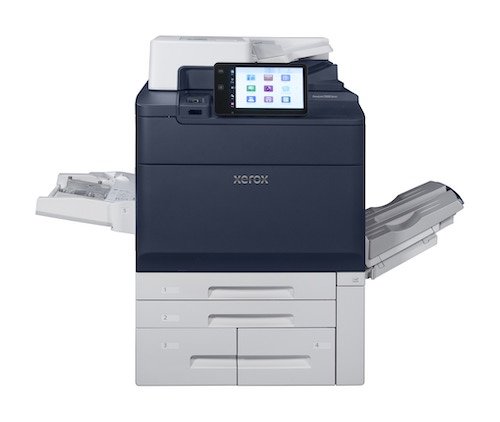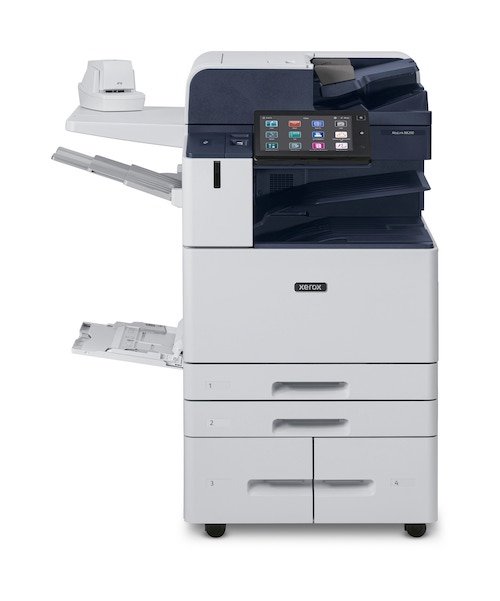It’s not easy to determine which printer brand or model to buy if you don’t have a firm understanding of what to look for in a machine.
It becomes even more difficult when talking about production printers, which is what we’ll be covering today.
Production-style printers meet very specific needs, and the truth is, most consumers will not need to invest in one.
As a long-time local print vendor, we have acquired the necessary knowledge to determine when a production-style machine is needed and can identify who will be suitable for one.
Having been Xerox partners for nearly 40 years, we are experts in the company’s production product family. This includes PrimeLink printers, which we’ll be focusing on here.
We are committed to providing unbiased information and prioritizing education in our content. There are many reputable brands offering solid production printers that may better fit your needs.
With that out of the way, let’s explore the PrimeLink family. We’ll discuss its features, different models, and cost to help you evaluate whether it could be an option for you.
Explore all Xerox printer families in our Ultimate Guide to Xerox Machines.
What Printers Are in the Xerox PrimeLink Family?
The PrimeLink family is divided into two main categories: color and black-and-white. There are seven machines in total. They are as follows:
- PrimeLink C9065 & C9070
- PrimeLink C9265, C9275, and C9281
- PrimeLink B9100, B9110, B9125 and B9136
We’ll discuss the differences between the two categories in more detail later. However, it’s important to note that all PrimeLink machines are entry-level production printing options.
If you would like a more in-depth look at the models in the PrimeLink family, read these review blogs:
- PrimeLink C9265 Review
- PrimeLink C9275 Review
- PrimeLink C9281 Review
- PrimeLink B9100 Review
- PrimeLink C9065 Review
The base model of a printer in the PrimeLink B9200 Series:

4 Xerox PrimeLink Features
Now that you know which models make up the PrimeLink family of printers, let’s look at four notable features of these machines:
1. Advanced Color Technology and Image Quality
The key feature of the PrimeLink machines is their print resolution along with advanced color technology.
The C9200 Series features a new HD LED print engine that replaces older laser technology, resulting in quieter operation and improved energy efficiency. The color series also has a 10-bit 2400 x 2400 dpi resolution.
The color printers in the PrimeLink C9200 Series come standard with the Xerox Integrated Color Server. They can be upgraded with EFI servers embedded with Pantone Plus technology, which will help ensure you get the colors you desire in your prints.
Plus, the color series comes equipped with High-Definition Emulsion Aggregate (HD EA) Toner, utilizing 4-micron particles and low melting point technology akin to Iridesse models. This results in bright, sharp prints that mimic offset printing, showcasing professional details and smooth color transitions.
Learn more about the key features of the newest PrimeLink C9200 Series here.
Example of color prints made on the PrimeLink C9200 Series printers:

On the PrimeLink C9065 and C9070 printers, you can include Xerox’s Adaptive CMYK Plus Technology. This technology features the Xerox Vivid Toner Kit, which includes gold, silver, white, and clear toner colors. Additionally, it offers Xerox’s Fluorescent Toner Kit, which adds impact with fluorescent cyan, magenta, and yellow.
The PrimeLink B9100 Series also has a print resolution of 2400 x 2400 dpi (dots per inch) and contains multiple image quality enhancement features.
Additionally, this series includes Vertical Cavity Surface Emitting Laser (VCSEL) technology, which contributes to image quality by using 32 lasers to provide consistent print densities and natural grays.
Other image quality enhancement features include Simple Image Quality Adjustment (SIQA), Digital Image Registration Control Technology (IReCT) and an optional Xerox EX B9100 Fiery Print Server that can provide performance-boosting features such as automation and advanced job setup.
2. Specialty Prints and Finishing Options
Another defining feature of the PrimeLink machines is their ability to produce specialty prints. These include booklets, pamphlets, manuals, posters, and window clings, among others. Additionally, they offer a wide range of finishing options.
The PrimeLink C9065, C9070, and the B9100 Series printers enable you to print on specialty and heavyweight stocks up to 350 gsm (grams per square meter). There’s also an Extra Long Sheet capability that expands your printing size potential to 26 inches and accommodates weights up to 220 gsm.
The PrimeLink C9200 Series offers the ability to print on specialty and heavyweight stocks up to 400 gsm single-sided and 350 gsm double-sided. It also allows for Extra-Long Sheet (XLS) printing up to 51 inches (1,300 mm).
Some of the noteworthy finishing options you can have included with your PrimeLink machine include:
- Xerox Production Ready Finisher - Can handle additional various stapled sheet sizes and paper weights of 52-350 gsm uncoated (72-350 gsm coated) for both stacking and stapling.
- Xerox Production Ready Booklet Maker Finisher - Produces booklets of up to 200 pages and includes a 500-sheet top tray and 3,000-sheet stack tray.
- Xerox Squarefold Trimmer - Creates flat-edged finished booklets and allows for professional face trim up to 120 pages (30 sheets).
Check out our guide on all Xerox PrimeLink finishing options here.
Upon purchasing a PrimeLink printer, you can buy finishing options to customize your machine to best fit your needs.
However, to avoid overspending on finishing options you don’t need, talk to your print vendor and go over the types of prints you will be making. That will give you a roadmap to navigate which finishing options would be worth investing in.
3. Xerox App Gallery
PrimeLink devices can enhance business processes by downloading various applications from the Xerox App Gallery, which is part of Xerox’s ConnectKey technology.
The app gallery boasts cloud connectivity apps that link to services such as Box, Microsoft OneDrive, Google Drive, Dropbox, and Microsoft Office 365.
It also features industry-specific applications tailored for the education, legal, and healthcare sectors, as well as general apps like Xerox Translate and Print, Quick Link, and Summarizer.
Xerox ConnectKey technology lets you use the features of an office copy machine, such as extra productivity apps and faxing, while also allowing you to print high-quality, professional-level prints.
For more information on the Xerox App Gallery, read these blogs:
- 6 Printer Apps for Increased Office Productivity
- 5 Best Printer Apps for the Educational Environment
- 5 Printer Apps for the Legal Environment
4. Printer Security
Stringent security features are essential for PrimeLink devices because cybercrimes are becoming more common. This is especially true for printers, which are often overlooked as a cybersecurity threat.
A few of the PrimeLink security features include:
- Data encryption, access controls, disk overwrite, and industry certifications.
- Audit Log - Ensures an audit trail of operators’ key events. These logs can be used for troubleshooting, resource optimization and security audits.
- Secure Print - Holds documents for release until you’re ready to retrieve them.
- Secure scanning - Allows you to password-protect PDF documents and folders while also allowing for encryption for scanning to email.
PrimeLink printers adhere to industry standards, such as HIPAA and FIPS 140-2, which further exemplifies devotion to security protocols.
Read our blogs about Xerox’s approach to cybersecurity and four ways to prevent cyberattacks to learn more about printer security.
How Is PrimeLink Different from Xerox’s Other Product Families?
Xerox has five main product families: personal desktop printers, VersaLink, AltaLink, PrimeLink, and larger production printers.
Since desktop printers and VersaLink machines aren't comparable to the more advanced devices in Xerox’s lineup, it wouldn't be practical to discuss their differences with PrimeLink printers.
If you're considering a PrimeLink production machine, it's important to understand how it compares to Xerox's larger, advanced production presses.
You might also be curious about how PrimeLink devices differ from AltaLink machines, as PrimeLink printers are an upgrade from AltaLink models.
Below are the key differences between PrimeLink devices and the two families worth comparing:
Difference Between Xerox PrimeLink and AltaLink
The main differentiator between PrimeLink and AltaLink devices is they each meet different workplace goals.
For instance, if you want the ability to consistently print calendars, manuals, training manuals or other specialty prints, PrimeLink production printers are specifically built to handle that demand at a high volume.
While AltaLink devices can meet the needs of large workgroups looking for a multifunction printer, they are not classified as production machines and can’t make all the specialty prints that PrimeLink devices make.
If you would like to learn more about the differences between AltaLink and PrimeLink devices, read our blog about the Xerox AltaLink printer family.
An example of a machine in the AltaLink B8200 Series:

2 Differences Between Xerox PrimeLink and Advanced Production Printers
Here are two differences worth mentioning between the PrimeLink family of printers and the more robust production presses that Xerox offers:
1. Print Speeds
Xerox has multiple other, more advanced production-style machines, including the Xerox Versant 280 Press, Xerox Versant 4100 Press, and the Xerox Iridesse Production Press.
A key difference between the PrimeLink devices and the production presses is the advanced production options have higher print speeds.
For example, the PrimeLink C9265 prints at speeds of up to 65 pages per minute (ppm) in color. All the advanced options print at higher print speeds: The Versant 280 press prints up to 80 ppm, the Versant 4100 Press prints up to 100 ppm, and the Iridesse Production Press prints up to 120 ppm.
2. Print Volume
The same logic behind print speeds applies to print volume. The more advanced production presses have the capacity to print at a higher volume than the PrimeLink machines.
The PrimeLink C9265 has a recommended monthly print volume of 60,000 pages. Each of the production printers listed in the last section has higher recommended monthly print volumes:
- Versant Press 280 – Up to 80,000 pages
- Versant Press 4100 – Up to 250,000 pages
- Iridesse Production Press - Up to 475,000 pages
The increasing print volume indicates that the advanced options cater to companies that specialize in high-volume printing.
This means PrimeLink devices aren’t the ideal choice for anyone seeking a production printer capable of printing over 50,000 pages in a month.
Example of Iridesse Production Press:

3 Differences Between Xerox PrimeLink Models
Now that we’ve covered the differences between the Xerox product families, let’s examine the key factors that set the models apart in the PrimeLink product catalog.
1. Color Printing Capability
This was mentioned previously, but the two PrimeLink Series differ in the type of prints they can make.
The PrimeLink C9065, C9070, and the C9200 Series are the color printers in Xerox’s PrimeLink category. On the other hand, the four machines that make up the B9100 Series are exclusively black-and-white printers and cannot print in color.
2. Print Speed
Another fundamental difference between the PrimeLink color and black-and-white printers is that the efficiency of the printer will increase as the model gets more advanced in the series.
For example, the PrimeLink C9265 has a print speed of up to 65 pages per minute (ppm) in color and in black-and-white.
The more advanced C9270 model has slightly more efficient print speeds of 70 ppm in color and in black-and-white.
The same logic applies to the PrimeLink B9100 Series, as well.
The B9100 model has print speeds of up to 100 ppm, the B9110 model has print speeds of up to 110 ppm, the B9125 has print speeds of up to 125 ppm and the B9136 model has print speeds of up to 136 ppm.
3. Printer Cost
As you can likely guess, the more advanced models in the PrimeLink family will also be more expensive.
To show a representation of price, here are the estimated base costs of the current PrimeLink models:
- PrimeLink C9065 ($19,800)
- PrimeLink B9100 ($18,700)
As you can tell, PrimeLink production printers can be pricey. The base cost doesn’t include any additional upgrades you might want or the Fiery Print Server that will likely be necessary to execute production features.
However, if you’re already outsourcing marketing materials or other large-high-quality print jobs, bringing those jobs in-house will, in most cases, save you money.
It’s important to note that some print vendors may offer trade-ins for older machines. And, most will give you the option to lease your printer, rather than purchase it outright. Leasing a printer will break up the total price of the machine into monthly payments, making it a more affordable option. For more printer cost information, read these blogs:
- How Much Does a Copier/Printer Cost?
- Leasing vs. Purchasing a Copier/Printer
- 6 Things to Consider When Buying a Copier/Printer
How Does Xerox PrimeLink Series Compare to Other Brands?
It would be unrealistic to offer a comprehensive comparison of production-style printers across different brands. That’s a different blog for a different day.
However, it should be noted that many brands in the industry have solid printers with their own unique qualities that can meet a wide array of printing needs.
Some other notable printers include Konica Minolta’s bizhub C751i and Ricoh’s IM C8000.
For a look into the more advanced production options in Xerox’s catalog, as well as additional information on who’s fit for a production machine, read our blog on whether a production printer is right for you.
Who Is a Fit for a Xerox PrimeLink Printer?
Now, let’s go over who would be a good fit for a PrimeLink device:
- Businesses that are interested in an entry-level production printer.
- Businesses that have a daily need to make specialty prints, like booklets and manuals, at a high volume (between 50,000-700,000 pages per month)
- Businesses that require special finishing options for booklets and other specialty prints.
- Businesses that desire advanced color technology and image quality enhancements in a production-style printer.
If you fit into these four categories, then you are likely a candidate for a printer in the PrimeLink product catalog.
However, PrimeLink devices also require you to have specific electrical requirements and office space to install, and it’s important to consider this if you have an ideal spot for a production-style machine in your workplace.
Read our blog on the difference between printer equipment requirements and space requirements to learn more.
Who Isn’t a Fit for a Xerox PrimeLink Printer?
Let’s now go through who would not be a fit for the PrimeLink family:
- You have a small-to-medium-sized office with a relatively small office equipment budget.
- You don’t need to make pamphlets, posters, manuals or any other specialty print.
- You don’t print at a significant volume and align more with a basic single-function or multifunction printer.
- You need a production printer that can print over 50,000 pages per month.
- You don’t have the space or electrical requirements to accommodate a production printer.
If you fall into one of these categories, then you are most likely not a candidate for a PrimeLink device and will need to look at other Xerox offerings.
If you’re looking for a basic single-function or multifunction printer, you should consider the VersaLink product catalog. If you need a step above the basic multifunction print options but don’t require the ability to make specialty prints, then the AltaLink product catalog would be the better option.
Finally, if you desire an advanced production machine, then models like the Iridesse Production Press and Versant 4100 Press will be the best fit for you.
Read our blog about how to choose a printer for your budget and business needs for more tips on how to choose the printer that best optimizes your printing processes.
Think a Xerox PrimeLink Printer Is Right for You?
As far as production printers go, the PrimeLink models in Xerox’s arsenal represent a solid entry-level option in the production category.
PrimeLink printers serve as a dual-option machine in that they combine features such as print, copy, fax and apps while allowing you to have production-level print quality.
PrimeLink devices are equipped with advanced color technology and image optimization features that enhance print quality and contain numerous customization options when it comes to finishers and accessories.
However, production-style printers will not be a fit for most people and meet the specific needs of companies that make special kinds of prints and need an entry-level production printer.
Our nearly 40 years as a print vendor have taught us that seeking the help of experts in the industry is paramount when seeking a long-term printing solution, especially when it comes to production printers that can run into the tens of thousands of dollars.
If you are interested in a PrimeLink machine or would like to discuss other printing solutions, reach out to us and a business consultant will be there to assist you.
